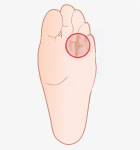Foot Ailments
Toes
- Blisters
- Bunions
- Corns and Calluses
- Hammertoes
- Ingrown Toenails
- Nail Remedies
- Overlapping Toes
- Thick Yellow Toenails
- Toe Pain Pinched Toes
Ball
Arch
Heel
Entire Foot
- Arthritis
- Athletes Foot
- Blisters
- Bromhidrosis
- Bursitis
- Charcot Foot
- Cold Feet
- Corns
- Diabetic Neuropathy
- Dry Skin
- Foot Odor
- Foot Perspiration
- Hot Feet
- Hyperhidrosis
- Itchy Feet
- Pronation
- Supination
- Swollen Feet Legs Edema
- Tarsal Tunnel Syndrome
- Tired Aching Feet
- Wide Feet
Leg Ailments
Entire Leg
- Arthritis
- Circulation
- DVT
- Economy Class Syndrome
- Swollen Feet Legs Edema
- Heaviness In Legs
- Leg Length Discrepancy
- Leg Pain
- Leg Veins
- Shin Splints
- Spider Veins
- Swollen Feet & Legs
- Varicose Veins
- Venous Insufficiency
- Wide Calves
Ankle
Knee
Back Ailments
Entire Back
MORTON'S NEUROMA
Learn more about diagnosis, treatment, and prevention.

Could I have Morton's Neuroma?
To start finding out, take a closer look at where you feel pain in your foot.
What areas of my foot hurt?
Morton's neuroma affects these regions of
your foot:
A Toes
B Ball of foot
What is Morton's Neuroma?

A neuroma is simply a swollen nerve. Morton's neuroma occurs in
the nerves at the base of the toes on the bottom of the foot, most commonly between the third and fourth toes.
If a nerve is repeatedly pinched or irritated, it will enlarge and, like a scar, develop extra fibrous tissue. The aggravated nerve can cause numbness, tingling, burning, or shooting pains. The condition is sometimes referred to as a nerve tumor, neuritis, or perineural fibroma.
What causes Morton's neuroma isn't fully known, but the experts at FootSmart agree that YOU MAY BE SUSCEPTIBLE TO THE CONDITION IF YOU:
- Have flat feet or rigid arches. Both lead to increased pressure and stretching of the nerve.
- Wear high heels, which force extra weight to the front of the foot.
- Wear tight shoes, which cramp the toes, pinching the nerves.
- Often crouch or stoop, which can stretch and irritate the nerves.
Think you might have Morton's neuroma?
TAKE THIS SELF-ASSESSMENT
Self- Assessment Quiz
- A numb or tingling sensation in the toes or the ball of the foot?
- A burning or shooting pain in the toes or ball of my foot?
- The feeling of a bulge or fullness between my toes?
- The feeling that my toes are asleep?
- Feeling like I'm walking on a wrinkled or crumpled sock?
- Cramping of the toes or a clicking feeling when I walk?
- A frequent urge to take off my shoe and massage my foot?
If you answered “yes” to any of these questions, you show some key symptoms of having Morton's neuroma. TAKE THE NEXT QUICK QUIZ.
Self- Assessment Quiz
- Applying pressure aggravates the pain.
- Wearing shoes aggravates the pain.
- The toes closest to the pain are starting to spread.
- I've had to curtail my activities because of the pain.
- The pain is getting worse over time.
If any of these statements are true, you may have Morton's neuroma. Make an appointment with a podiatrist to confirm your condition. This is important since symptoms are similar to stress fractures. Keep reading for recommendations on treatment and relief from the experts at FootSmart.
Are there any serious concerns with Morton's Neuroma?
Many cases of Morton's neuroma will clear up with at-home treatment. If you have pain that does not respond to those treatments and affects your daily activities, you may need injections or even minor surgery.
How do I treat and prevent Morton's Neuroma?
Treatment for mild cases can be as simple as wearing a special pad and the right shoes. More severe cases may require steroid injections or minor surgery.

Wear shoes with:
- Wide toe boxes to prevent compression
- Low heels to reduce weight on the ball of the foot.
To find relief from the discomfort, you need to reduce pressure on the nerve. The experts at FootSmart recommend that you:
- Use metatarsal cushion pads or inserts. These pads and inserts help support your arch, provide space between your toes, and relieve pressure on your pinched nerve.
- Use orthotics to change the weight distribution on the foot and provide arch support.
- Tape the toe area.
- Stretch your toes regularly.
- Wear shoes with wide toe boxes to prevent compression.
If pain persists, your podiatrist may recommend injections of the steroid cortisol, or possibly alcohol solutions or Vitamin B12.

Will I need surgery?
If the injections don't help, your podiatrist may recommend surgery to remove the nerve or otherwise relieve the tension in the area. Here's what you need to know:
- The success rate is high. Nearly all patients find relief after surgery, though many do experience permanent numbness in the area between the toes.
- Recovery is quick. You'll be off your feet a couple days and then using crutches or other assistance for about three to four weeks.
- Neuromas sometimes recur. If yours does, your podiatrist may recommend freezing or sealing the nerve with a laser.
RELATED CONDITIONS
RELATED ACTIVITIES
- Running
- Walking
- Activities that involve crouching and stooping

